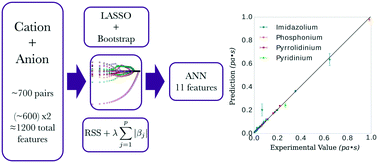当前位置:
X-MOL 学术
›
Mol. Syst. Des. Eng.
›
论文详情
Our official English website, www.x-mol.net, welcomes your
feedback! (Note: you will need to create a separate account there.)
Statistical models are able to predict ionic liquid viscosity across a wide range of chemical functionalities and experimental conditions†
Molecular Systems Design & Engineering ( IF 3.2 ) Pub Date : 2018-01-12 00:00:00 , DOI: 10.1039/c7me00094d Wesley Beckner 1, 2, 3, 4 , Coco M. Mao 1, 2, 3, 4 , Jim Pfaendtner 1, 2, 3, 4, 5
Molecular Systems Design & Engineering ( IF 3.2 ) Pub Date : 2018-01-12 00:00:00 , DOI: 10.1039/c7me00094d Wesley Beckner 1, 2, 3, 4 , Coco M. Mao 1, 2, 3, 4 , Jim Pfaendtner 1, 2, 3, 4, 5
Affiliation

|
Herein we present a method of developing predictive models of viscosity for ionic liquids (ILs) using publicly available data in the ILThermo database and the open-source software toolkits PyChem, RDKit, and SciKit-Learn. The process consists of downloading ∼700 datapoints from ILThermo, generating ∼1200 physiochemical features with PyChem and RDKit, selecting 11 features with the least absolute shrinkage selection operator (LASSO) method, and using the selected features to train a multi-layer perceptron regressor—a class of feedforward artificial neural network (ANN). The interpretability of the LASSO model allows a physical interpretation of the model development framework while the flexibility and non-linearity of the hidden layer of the ANN optimizes performance. The method is tested on a range of temperatures, pressures, and viscosities to evaluate its efficacy in a general-purpose setting. The model was trained on 578 datapoints including a temperature range of 273.15–373.15 K, pressure range of 60–160 kPa, viscosity range of 0.0035–0.993 Pa s, and ILs of imidazolium, phosphonium, pyridinium, and pyrrolidinium classes to give 33 different salts altogether. The model had a validation set mean squared error of 4.7 × 10−4 ± 2.4 × 10−5 Pa s or relative absolute average deviation of 7.1 ± 1.3%.
中文翻译:

统计模型能够预测各种化学功能和实验条件下的离子液体粘度†
本文中,我们介绍了一种使用ILThermo数据库和开源软件工具包PyChem,RDKit和SciKit-Learn中公开可用的数据开发离子液体(IL)粘度预测模型的方法。该过程包括从ILThermo下载约700个数据点,用PyChem和RDKit生成约1200个理化特征,用最小绝对收缩选择算子(LASSO)方法选择11个特征,并使用所选择的特征来训练多层感知器回归器-一类前馈人工神经网络(ANN)。LASSO模型的可解释性允许对模型开发框架进行物理解释,而ANN隐藏层的灵活性和非线性则可以优化性能。该方法在各种温度,压力,和粘度以评估其在通用环境中的功效。该模型在578个数据点上进行了训练,包括273.15–373.15 K的温度范围,60–160 kPa的压力范围,0.0035–0.993 Pa s的粘度范围以及咪唑鎓,nium,吡啶鎓和吡咯烷鎓类的IL,可提供33种不同的盐共。该模型的验证集均方误差为4.7×10−4 ±2.4×10 -5 Pa s或7.1±1.3%的相对绝对平均偏差。
更新日期:2018-01-12
中文翻译:

统计模型能够预测各种化学功能和实验条件下的离子液体粘度†
本文中,我们介绍了一种使用ILThermo数据库和开源软件工具包PyChem,RDKit和SciKit-Learn中公开可用的数据开发离子液体(IL)粘度预测模型的方法。该过程包括从ILThermo下载约700个数据点,用PyChem和RDKit生成约1200个理化特征,用最小绝对收缩选择算子(LASSO)方法选择11个特征,并使用所选择的特征来训练多层感知器回归器-一类前馈人工神经网络(ANN)。LASSO模型的可解释性允许对模型开发框架进行物理解释,而ANN隐藏层的灵活性和非线性则可以优化性能。该方法在各种温度,压力,和粘度以评估其在通用环境中的功效。该模型在578个数据点上进行了训练,包括273.15–373.15 K的温度范围,60–160 kPa的压力范围,0.0035–0.993 Pa s的粘度范围以及咪唑鎓,nium,吡啶鎓和吡咯烷鎓类的IL,可提供33种不同的盐共。该模型的验证集均方误差为4.7×10−4 ±2.4×10 -5 Pa s或7.1±1.3%的相对绝对平均偏差。











































 京公网安备 11010802027423号
京公网安备 11010802027423号